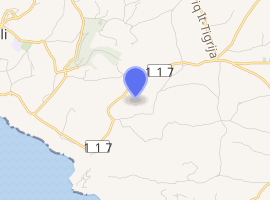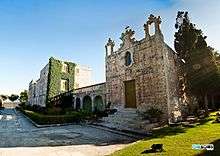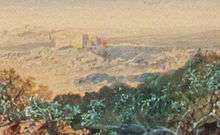Girgenti Palace
Girgenti Palace (Maltese: Palazz tal-Girgenti) is a palace near Siġġiewi, Malta. It was built in 1625 as the summer residence of Malta's inquisitor, and is therefore also known as the Inquisitor's Palace (Maltese: Palazz tal-Inkwiżitur; colloquially: tal-Inkisitur).[1] It is now an official residence of the Prime Minister of Malta.
| Girgenti Palace | |
|---|---|
Palazz tal-Girgenti | |
.jpg) View of the palace | |

| |
| Alternative names | Inquisitor's Palace and gardens |
| General information | |
| Status | Intact |
| Type | Palace |
| Location | Siġġiewi, Malta |
| Coordinates | 35°51′4.2″N 14°24′24.6″E |
| Current tenants | Prime Minister of Malta |
| Completed | 1625 |
| Owner | Government of Malta |
| Technical details | |
| Material | Limestone |
History

Girgenti Palace was built in 1625 as the summer residence of Inqusitor Onorato Visconti, on a strip of land confiscated from Matteo Falson or Falzon (Maltese: Matti Falzun), who had been condemned as a heretic.[2] Falzon was not accused alone as also Cleric Wenzu Falzon had been accused with him of witchcraft. Wenzu took a self-exile in France were he continued a life of against church teaching and Matti went into hiding in Sicily. Both were sentenced in absentia by the inquisition with representative ‘corps’. No property at all was taken from Wenzu as he had nothing of real value left behind. Matti remained known by the locals as the "Falzon Wizard" (Maltese: is-Saħħar Falzun).[3]
The palace has a simple layout, with its rooms arranged in a rectilinear layout. It has a plain façade, with few decorative elements.[4]
A chapel dedicated to St Charles Borromeo was built near the palace in 1763 by Inquisitor Angelo Maria Durini.[5]

The palace remained the summer residence of the inquisitors until 1798, when the Inquisition was abolished during the French occupation of Malta. It was subsequently used as a summer residence for the Lieutenant-Governors of Malta. In World War II, some of the collections of the Palace Armoury were stored at Girgenti Palace for safekeeping.[2][6]
The palace was left abandoned until it was restored between 1988 and 1990, and converted into the summer residence of the Prime Minister of Malta.[7]
It is occasionally open to the public.[8][9]
The palace was included on the Antiquities List of 1925.[10]
Both the palace and its chapel are listed on the National Inventory of the Cultural Property of the Maltese Islands.[2][5]
Further reading
References
- Cassar Pullicino, Joseph (October–December 1949). "The Order of St. John in Maltese folk-memory" (PDF). Scientia. 15 (4): 163. Archived from the original (PDF) on 17 April 2016.
- "Inquisitors Palace and Gardens" (PDF). National Inventory of the Cultural Property of the Maltese Islands. 28 December 2012. Retrieved 18 July 2015.
- Gatt, Guze (June 1937). "L-Iskejjel tal-Gvern: it-Taghlim f'Malta" (PDF). Lehen il-Malti (in Maltese). Empire Press. 5 (76): 99–101.
- "Inquisitor's Palace at Girgenti, Siġġiewi". Times of Malta. 15 November 2012. Retrieved 18 July 2015.
- "Chapel of San K. Borromeo" (PDF). National Inventory of the Cultural Property of the Maltese Islands. 28 March 2014. Archived from the original (PDF) on 21 July 2015. Retrieved 18 July 2015.
- Spiteri, Stephen C. (2003). Armoury of the Knights: A Study of the Palace Armoury, Its Collection, and the Military Storehouses of the Hospitaller Knights of the Order of St. John. Midsea Books. p. 223. ISBN 978-9993239451.
- "Girgenti Palace". malta.com. Retrieved 18 July 2015.
- Galea Debono, Fiona (5 November 2006). "Visitors throng Girgenti Palace". Times of Malta. Retrieved 18 July 2015.
- "Mdina, Girgenti delight the crowds". Times of Malta. 19 April 2009. Retrieved 18 July 2015.
- "Protection of Antiquities Regulations 21st November, 1932 Government Notice 402 of 1932, as Amended by Government Notices 127 of 1935 and 338 of 1939". Malta Environment and Planning Authority. Archived from the original on 19 April 2016.